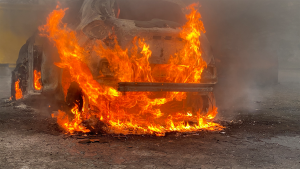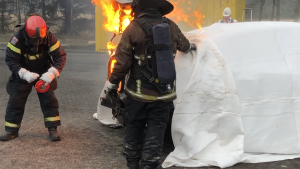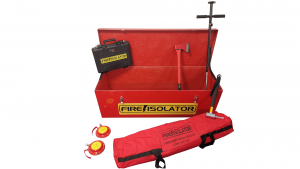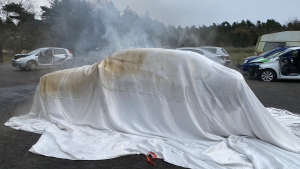Lithium batteries present a range of risks and intervention difficulties that are becoming increasingly pressing thanks to the growing number of electric car fires in a wide variety of contexts. One of the best methods for preventing collateral damage is the so-called Fire Isolator fire blanket, which, along with other elements, is part of the Fire Isolator concept. This is the solution developed for fire fighters, rescue workers, car transporters, ship crews, workshops, and all of the most critical places where it is a priority to contain electric car fires in a short time.
When an electric car’s battery catches fire (called thermal runaway), the cells continue to burn in an exothermic chain reaction, releasing toxic gases. The risk is that once the covering effect of the fabric fails, the huge amount of energy, which is only being ‘compressed’, takes over.
From these considerations, T-ISS, a company specialising in the production of safety products and safety signage, developed and tested the Fire Isolator concept.

How does Fire Isolator control electric car fires?
Fires onboard ferries and car carriers as well as in parking garages are emblematic cases of a priority that, does not only concern the maritime transport of electric vehicles. The Fire Isolator is, in fact, a technique based on the synergy of different elements as a currently tested solution to control the fire of an electric car.
In tests carried out with support from the Dutch, Danish, Canadian, Japanese, Thai, Korean and Taiwanese fire brigades, the company has demonstrated how the combination of different extinguishing methods best minimises collateral damage from electric car fires on a ship or in a car park. The Fire Isolator provides the simultaneous use of:
- A fire blanket resistant to high temperatures;
- A water mist lance (water mist) that produces very small water droplets;
- Encapsulated low-pressure aerosol units that interrupt the chemical reactions in the flames, increasing the effectiveness of the fire blanket;
- Thermal imaging camera for temperature monitoring during and after the fire; and
- Adequate training in application of the Fire Isolator concept.
Jan Peter Verheuvel, Fire Isolator Marketing Manager, said: “Everyone knows the problem when a car with a lithium-ion battery burns out: it can’t be simply extinguished with water alone because the fire in the battery will keep reigniting. The only way to really put out the fire, based on our tests, is to submerge the car under water for several days and cool it down.
“This cannot be done on a ferry, in a car park or on a busy street. That is why we created Fire Isolator, which aims to isolate and control the fire until the ship reaches a port. Or in the case of an EV fire in a car park, until the car can be safely removed and submerged in a container filled with water.”
The success of the concept and whether it is at all possible to deploy it, depends on the reaction time after a fire or heating up battery has been detected. This is why early detection systems are important, along with sprinkler systems in carparks or drenching/water mist systems onboard car carriers and ferries.
There are also cases where the space between the cars is too small to even reach the car. In those cases, we need to rely on other tactics or develop customisations of our concept, such as a wider blanket that covers multiple cars at once with one blanket. Training is even more important in these cases.
Step 1: The Fire Isolator fire blanket
Firefighters intervening at the burning electric car start by covering the car with the high-temperature blanket FI-BL0906, a 9x6m blanket that is certified to resist flames according to standard ASMT D6413 and ISO EN 13501-1.

This blanket is specially designed for electric car fires and can withstand peak temperatures of 1600°C (2900°F) or continuous exposure to temperatures of 1100°C. It can be reused six or seven times, according to the company, only needing to be washed with water and put it back in its cover. The Fire Isolator Blanket can also be applied to vehicles in the immediate vicinity of the fire to prevent heat/fire damage.
To contain fires in smaller objects than cars, such as stored lithium-ion batteries, eBikes, eScooters etc., Fire Isolator has a range of smaller blankets (2x2m and 3x3m) of the same material and with the same characteristics. Based on the customers’ requirements, we can produce almost any size blanket.
Step 2: Defeat toxic gases with water mist
Using the lance that produces water mist, helps to further dissipate the heat with the evaporation of the droplets, and to break down the toxic gases escaping from the fire blanket.
Unlike classic extinguishing methods where water is used directly on the battery to cool it down, the supply of water in this case serves mainly to seal the fire blanket on the car.

The company explains that thanks to cooperation with fire brigades in South Korea and Taiwan, the method has been further refined.
Verheuvel said: “By already spraying the water mist onto the blanket before the aerosol units are activated, the sealing effect of the blanket and the effectiveness of the extinguishing aerosol is increased.
“We received this feedback from Korean and Taiwanese firefighters who conducted the tests and this method has become a best practice.”
Step 3: The Fire Isolator aerosol units
After applying the fire blanket, and after the water mist is sprayed on the car/blanket, staff activate a low-pressure aerosol unit and throw it under the blanket, as close to the battery as possible. It is a solid microparticle-based aerosol that replaces oxygen in the space between the car and the fire blanket.
Unlike the extinguishers known as Halon (organic halogen compounds containing bromine, fluorine and sometimes chlorine atoms), this solution is more environmentally friendly and draws energy from the flames without using large amounts of water, which instead entails the drawback of collection and disposal.

Verheuvel, explaining the process, said: “In car fires involving lithium batteries, we managed to kick down the flames until the temperature dropped to 200-300°C.”
Step 4: Monitoring with infrared thermal camera
Using a thermal imaging camera is essential from the early stages of fighting the fire, as it helps to control the progress of the fire and locate the hottest points of the car. If, after the deployment of the first aerosol unit, the temperature should rise, the use of further aerosol units is advised. Each Fire Isolator set contains two of these aerosol units.
A step-by-step animated instruction on how to deploy the Fire Isolator concept is available here:
Verheuvel said: “With the Fire Isolator concept, we have made it easier to control fires involving Li-ion batteries. There is a lot of interest from different sectors, especially shipping, logistics (storage of lithium-ion batteries), parking garages, fire brigades, fire protection companies, and automotives.”
By now, we have a long customer list and dealers all over the world that you can contact to learn more about the concept and ask for pricing information.
Fire Isolator is a solution that will help many automotive, parking and shipping companies provide specific tools to minimise the collateral damages of electric car fires.
On the Fire Isolator website, you can read more about the concept, view testing videos, download datasheets and other materials. The FAQ on our website provides answers to the most frequently asked questions and our blog will keep you updated on the latest developments in the world of electric car fire control.

